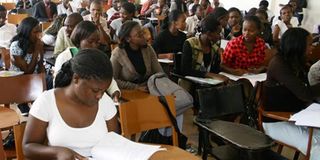The crisis in our universities starts from sub-standard teaching in lecture rooms

Students in a lecture hall at one of the local universities. FILE PHOTO |
What you need to know:
- The biggest tragedy facing our universities is the decline of the lecture as a teaching method.
- Universities have gone full circle in the reproduction of mediocrity.
The recent notice of closure of university satellite campuses in the centre of Nairobi is a pointer that the Commission for University Education (CUE) is waking to the reality that higher education in Kenya is going rogue.
The closures were an attempt at enforcing widely accepted rules that lectures should be delivered in designated places conducive for learning to take place.
If CUE were to muster enough courage and extend the same measures across the country, most satellite campuses outside Nairobi would have to close shop.
This is because most of them share addresses with supermarkets, hardware shops, and noisy bars in sooty, dingy buildings. However, while the initiative by CUE is laudable, it ignores the more serious matter of what exactly goes on in the lecture rooms in our universities.
DECLINE OF THE LECTURE
The biggest tragedy facing our universities is the decline of the lecture as a teaching method and in its place, the use of techniques that were the preserve of primary and secondary schools.
There is a reason we have lecture rooms in universities and classrooms in high schools. The reason lies in the nature of the knowledge that is shared at university.
Unlike lower levels, the status of knowledge here is largely constituted as unstable and contestable. Therefore, the role of the lecturer is less of teaching and more of provoking thought and promotion of a critical, independent opinion.
At university, the power dimension with regard to transmitting knowledge is shared between the students and the lecturer.
In school, the hierarchies are sharp and the teacher is the sole purveyor of knowledge. The best method of teaching at this level is mainly reading or writing notes on the board for students.
Unfortunately, most university teaching today is routinely rendered through reading out notes to students, who should, by all standards, be too intelligent for this mode of instruction.
There are cases where successive generations of students have received the same unrevised and unupdated notes despite the fact that knowledge is dynamic.
This partly explains why some of our graduates are less analytical and incapable of handling abstract thinking. The tragedy of reading out notes in lecture rooms is worsened when “busy” lecturers hand out their notes to be photocopied because they are moonlighting across other campuses.
This is the gravest sin of scholarship as it robs students of a critical experience that can only be found at university.
GONE FULL CIRCLE
There are several reasons the lecture method might struggle to reclaim its place in the academy.
First, universities have gone full circle in the reproduction of mediocrity. Those who were taught through handouts and dictation and never got exposed to thought-provoking lectures are now teaching at universities or seeking to do so.
Second, universities have rapidly declined as centres of research and seminars where ideas are shared and contested. Most lecturers only show up on campus when they have a class to dictate notes to or an examination to deliver.
Although research profiles have more financial and social returns than teaching profiles, the latter-day academic in the university is engaged in accepting a heavier teaching load for pay.
This means that dictating notes becomes the only option to complete the marathon lessons assigned to a lecturer. The most significant reason lectures in universities are becoming less and less could be that they demand plenty of reading and preparation on the part of the lecturer.
They also demand a continuous engagement with emerging research. More importantly, good researchers make good lecturers and if lecturers are not engaged in wide reading and research, university students should expect a raw deal in the lecture room.
To remedy the downturn in the lecture room, universities must first pay lecturers well to make consultancies and moonlighting less attractive.
Secondly, in addition to reining in campuses sandwiched between bars and brothels, CUE must also provide specific enforceable guidelines on how lectures should be delivered.
Instructional methods that do not expose students to wide reading, independent thinking, and regular lectures should have no place in the university.
Dr Omanga is the head of the Publishing and Media Studies Department at Moi University. [email protected]




